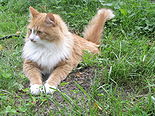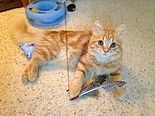Siberian cat
| Siberian | |
|---|---|
 Male red classic tabby | |
| Other names | Non-pedigree tabby long hair Siberian Forest Cat[1] Moscow Semi-longhair[2]Neva Masquerade (colourpoint variant) |
| Origin | |
| Breed standards | |
| CFA | standard |
| FIFe | standard |
| TICA | standard |
| WCF | standard |
| FFE | standard |
| ACF | standard |
| ACFA/CAA | standard |
| Domestic cat (Felis catus) | |
The Siberian is a domestic cat breed that has been present in Russia for centuries.[3] A longer name of the breed is Siberian Forest Cat,[1] but it is usually referred to as the Siberian or the Siberian cat.[3] Another name for it is the Moscow Semi-longhair.[2][clarification needed] The cat is an ancient breed that is now believed to be ancestral to all modern long-haired cats.[3] The cat has similarities with the Norwegian Forest Cat, to which it is likely closely related.[3] It is a natural breed of Siberia and the national cat of Russia.[citation needed] While it began as a landrace, it is selectively bred and pedigreed today in at least seven major cat fancier and breeder organisations. The colorpoint variant of the breed is called the Neva Masquerade by some registries, including Feline Federation Europe (FFE).
There are claims that it is hypoallergenic and produces less Fel d1 than other cat breeds.[citation needed]
History
The cat was first mentioned in a book by Harrison Wier, which included information of the earliest cat shows in England in 1871.[4][clarification needed] Siberians first arrived in the United States in 1990. Although gaining in popularity, the expense of importing the cats from Russia keeps the breed relatively rare outside of Europe.
In the Russian cat fancy, each cat club devises its own cat standards. This fact led to much confusion in the USA and other countries when the first Siberians were arriving and many appeared quite different from each other, depending on what area of Russia they originated from. One of the earliest written Siberian standards was publicized by the Kotofei cat club in St. Petersburg in 1987.[5] A Siberian cat, Dorofei, is owned by Russian Prime Minister Dmitry Medvedev, and another by former Soviet president Mikhail Gorbachev.[6] WBZ-AM talk radio host Steve LeVeille mentions his Siberian "Max" on his Boston-based program.[6]
Body
Known to be an exceptionally agile jumper, the Siberian is a strong and powerfully built cat, with strong hindquarters and large, well rounded paws. They have barreled chests and medium sized ears, broad foreheads, and stockier builds than other cats.[2] They also have a slight arch to their body.
Hypo-allergenic
Hypoallergenic qualities of the Siberian coat have been noted and commented on for almost ten years. While there is little scientific evidence, breeders and pet owners claim that Siberians can be safe for many allergy sufferers. Since females of all feline breeds produce lower levels of Fel d1, breeders often suggest that allergic families adopt female cats. Allergy sufferers are advised to check their reactivity directly with the parent cats from whom they plan to adopt a kitten.[7][clarification needed] Many people believe that the breed produces less Fel d1, the primary allergen present on cats.[4]
In 1999 Indoor Biotechnologies tested the fur of four cats for Fel d 1; a mixed breed, two Siberians, and an Abyssinian.[8] The results showed the Siberian and Abyssinian cat fur as having lower Fel d 1 levels than the mixed breed cat.[8] Indoor Biotechnologies cautions that the Siberian levels were still high, and that the mixed breed sample was "exceptionally high."[8] Indoor Biotechnologies warns against using these results to make decisions of pet ownership.[8]
This test of fur allergen levels is cited by many Siberian breeder websites as evidence the breed is hypoallergenic. Critiques include that the sample size is below statistical significance, was submitted by a Siberian breeder, and as mentioned, one cat was found to have Fel d1 allergen levels of 62,813 micrograms (roughly 60x higher than any published professional study).[9]
A not-for-profit association of breeders, (Siberian Research Inc), was founded in 2005 to study allergen levels and genetic diseases in the Siberian breed. As of March 2010, fur and saliva samples from over 300 Siberians have been submitted for analysis, many directly from a veterinarian. Salivary Fel d1 allergen levels in Siberians ranged from 0.08-27 µg per ml of saliva, while fur levels ranged from 5-1300 µg. The high-end of these ranges is consistent with results from prior studies, though the low end is below expected results.
All Siberians tested were found to produce some Fel d1, with the highest levels being found in Siberians that have silver coloured fur. About half of Siberians were found to have Fel d1 levels lower than other breeds, while under twenty percent would be considered very low. Within the low group, males and females had comparable allergen levels.[10]
This article may contain excessive or inappropriate references to self-published sources. (March 2013) |
Fur
Siberians express the three natural types of feline fur: guard hairs, awn hairs, and down. These three layers protect the cat from the Russian weather extremes, and provide a hardy, easy to care for coat today. The fur is textured but glossy, which decreases the occurrence of matting. A twice weekly combing is enough to keep the coat in good condition.
As with most other cat breeds, color varieties of the Siberian vary and all colors, such as tabby, solid, tortoiseshell and colorpoint are genetically possible. The Siberian cat breed does not have any unusual, distinct, or unique fur colorations or patterns.
Most breeders, enthusiasts, organizations, main registries such as TICA and the WCF, and countries accept the color point coloration as being natural. Color point Siberians are also known as "Neva-Masquerade": Neva for the river where they are said to have originated, and masquerade, for the mask-like coloration.[11][unreliable source?]
Siberian cats moult once or twice a year. The first moult is at the end of winter. The winter moult is instigated not by a change in temperature but by a change in day length. Many Siberians will experience a less intense "mini moult" at the end of the summer season.
Reproduction
Siberian cats tend to come into reproductive readiness earlier than other breeds, sometimes as young as five months. It is thought that this is related to the breed's closeness to its natural wild state. Feral cats often die young due to harsher natural conditions. Achieving reproductive ability early and having large litters provides a biological balance to this. On average, a Siberian litter consists of five to six kittens, as compared to the average litter of three to four kittens in breeds who have been registered as pedigreed cats. However, Siberian litters may consist of as few as one and as many as nine kittens.
Siberian cats are excellent parents, with the fathers helping to care for kittens if they are allowed access to the nest. Parents are often strongly bonded and some mothers will only mate with one male. Atypical for cats, juvenile male Siberians have been seen cuddling and grooming their cousins and siblings. Siberians, due to their communal nature, often do better in pairs in captivity.
If a Siberian is not desexed, some queens (females) have been noted to have litters as late as nine or ten years. However, kitten mortality is generally lower when the queens are between 18 months and five or six years of age. This is due to several factors: physical and emotional maturation of the female, health and vitality of the queen, and a natural predisposition to healthier offspring from younger mothers.
Males can father kittens from as young as five months to over ten years. In regions where the breed is rare and expensive a long term breeding career for a pedigreed male can create a risk of Popular Sire Syndrome, in which one male has an overly large genetic influence on the breed. In Eastern Europe, where the breed is very common and less expensive, this issue is less likely to arise.
During the early 1990s, it was expensive and difficult to locate and import Siberians. Therefor inbreeding became common. Since the breed is new to registration and breed books are open, breeders are able to add foundation stock to the breed. This reduces the level of relatedness in the breed, and increases vigor and vitality in the cats.
In popular culture
The breed can be seen in Russian paintings and writings dating back hundreds of years. This sets them apart from breeds that are the result of fairly recent selective breeding.[citation needed]
Vonda N. McIntyre introduces a Siberian Forest Cat as the pet of Spock's cousin Stephen in Enterprise the First Adventure (Pocket Books, 1986).
Gallery
-
Silver Shaded with White Siberian cat.
-
Blue Silver Mackerel Tabby Siberian cat.
-
Brown Patched Tabby with White Siberian cat.
-
Two Siberian brown mackerel tabby kittens.
-
Red Siberian cat, showing the characteristic round-shaped head.
-
Mocha Siberian with white patch on chest.
-
Siberian cat - 7 weeks.
-
Male siberian cat.
-
Seal Lynx color point adult male.
-
Siberian cat sleeping in its cage during the 2008 CFA International Cat Show in Atlanta.
-
A Siberian mix.
-
Siberian cats: Blue Silver spotted tabby with white (left), Brown Mackerel Tabby (right).
-
6 month old Siberian male red classic tabby.
References
- ^ a b Somerville, Louisa (2007). The Ultimate Guide to Cat Breeds. Edison, New Jersey, US: Chartwell Books. p. 86. ISBN 9780785822646.
According to legend, the Siberian Forest Cats traditionally lived in Russian monasteries, where they patrolled the rafters on the lookout for intruders. Although fierce, the monks treated them as loving and loyal companions.
- ^ a b c "Siberian Cat Breed Info". Retrieved 2009-08-08.[dead link]
- ^ a b c d "Cat Breeds of the World". A Complete Illustrated Encyclopedia. Viking. 1999.
- ^ a b "Siberian - Cat Breed Information & Breed Facts". Petside. Retrieved 2009-08-08.[dead link]
- ^ "Siberian cat - History". Siberian Cat World. Retrieved 2009-08-08.[dead link]
- ^ a b "Siberian". Cats 101. Season 2. Episode 2. 14 November 2009.
{{cite episode}}: Unknown parameter|serieslink=ignored (|series-link=suggested) (help) - ^ "The Show Cat Magazine - Siberian Cat". Retrieved 2009-08-08.
- ^ a b c d "The Siberian Cat...hypoallergenic??". Archived from the original on 2008-11-30. Retrieved 2008-11-29.
- ^ "Fel d 1 Production in the Cat Skin Varies According to Anatomical Sites". Allergy. 55 (6): 570–573. 2000. PMID 10858990.
{{cite journal}}: Unknown parameter|month=ignored (help) - ^ "Siberian Allergen Levels". SiberianResearch.com. Siberian Research Inc.[dead link]
- ^ "Siberian". CatsOfAustralia.com. Retrieved 2011-12-19.













